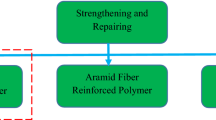Abstract
As the composite material of fiber reinforced plastic has the high strength with light weight unlike exiting metal materials, its usage is being gradually increased. In this study, the fracture behaviors are investigated with CFRP and existing metals of aluminum, brass and structural steel by 3-point bending test. As existing metal materials, the maximum reaction forces of 2250 N, 2500 N and 2400 N occurred at aluminum, brass and structural steel respectively. In contrast, the maximum force of about 4000 N was shown at CFRP. This study result can be applied to the durable design of composite structure.
Similar content being viewed by others
References
Kim, S.-S., Han, M.-S., Cho, J.-U., and Cho, C.-D., “Study on the Fatigue Experiment of TDCB Aluminum Foam Specimen Bonded with Adhesive,” Int. J. Precis. Eng. Manuf., Vol. 14, No. 10, pp. 1791–1795, 2013.
Harris, J. A. and Adams, R. A., “Strength Prediction of bonded Single Lap Joints by Non-Linear Finite Element Methods,” International Journal of Adhesion and Adhesives, Vol. 4, No. 2, pp. 65–78, 1984.
Michailidis, N., Stergioudi, F., Omar, H., and Tsipas, D. N., “An Image-based Reconstruction of the 3D Geometry of an Al Open-Cell Foam and FEM Modeling of the Material Response,” Mechanics of Materials, Vol. 42, No. 2, pp. 142–147, 2010.
Pradeep, K. R., Rao, B. N., Srinivasan, S. M., and Balasubramaniam, K., “Interface Fracture Assessment on Honeycomb Sandwich Composite DCB Specimens,” Engineering Fracture Mechanics, Vol. 93, No., pp. 108–118, 2012.
Aymerich, F., Onnis, R., and Priolo, P., “Analysis of the Effect of Stitching on the Fatigue Strength of Single-Lap Composite Joints,” Composites Science and Technology, Vol. 66, No. 2, pp. 166–175, 2006.
Ohno, N., Okumura, D., and Niikawa, T., “Long-Wave Buckling of Elastic Square Honeycombs Subject to In-Plane Biaxial Compression,” International Journal of Mechanical Sciences, Vol. 46, No. 11, pp. 1697–1713, 2004.
Nguyen, D.-T., Kim, Y.-S., and Jung, D.-W., “Finite Element Method Study to predict Spring-Back in Roll-Bending of Pre-Coated Material and Select Bending Parameters,” Int. J. Precis. Eng. Manuf., Vol. 13, No. 8, pp. 1425–1432, 2012.
Lee, J.-M., Lee, K.-H., Kim, B.-M., and Ko, D.-C., “Design of Roof Panel with Required Bending Stiffness Using CFRP Laminates,” Int. J. Precis. Eng. Manuf., Vol. 17, No. 4, pp. 479–485, 2016.
Stauder, B. J., Kerber, H., and Schumacher, P., “Foundry Sand Core Property Assessment by 3-Point Bending Test Evaluation,” Journal of Materials Processing Technology, Vol. 237, pp. 126–138, 2016.
Goncalves, J. P. M., De Moura, M. F. S. F., and De Castro, P. M. S. T., “A Three-Dimensional Finite Element Model for Stress Analysis of Adhesive Joints,” International Journal of Adhesion and Adhesives, Vol. 22, No. 5, pp. 357–365, 2002.
Lee, H. K., Pyo, S. H., and Kim, B. R., “On Joint Strengths, Peel Stresses and Failure Modes in Adhesively Bonded Double-Strap and Supported Single-Lap GFRP Joints,” Composite Structures, Vol. 87, No. 1, pp. 44–54, 2009.
Batra, R., and Peng, Z., “Development of Shear Bands in Dynamic Plane Strain Compression of Depleted Uranium and Tungsten Blocks,” International Journal of Impact Engineering, Vol. 16, No. 3, pp. 375–395, 1995.
Thipprakmas, S. and Boochakul, U., “Comparison of Spring-Back Characteristics in Symmetrical and Asymmetrical U-Bending Processes,” Int. J. Precis. Eng. Manuf., Vol. 16, No. 7, pp. 1441–1446, 2015.
Cho, J. U., Hong, S. J., Lee, S. K., and Cho, C., “Impact Fracture Behavior at the Material of Aluminum Foam,” Materials Science and Engineering: A, Vol. 539, pp. 250–258, 2012.
Zhao, O., Gardner, L., and Young, B., “Buckling of Ferritic Stainless Steel Members Under Combined Axial Compression and Bending,” Journal of Constructional Steel Research, Vol. 117, pp. 35–48, 2016.
Kim, S.-S., Han, M.-S., Cho, J.-U., and Cho, C.-D., “Study on the Fatigue Experiment of TDCB Aluminum Foam Specimen Bonded with Adhesive,” Int. J. Precis. Eng. Manuf., Vol. 14, No. 10, pp. 1791–1795, 2013.
Author information
Authors and Affiliations
Corresponding author
Rights and permissions
About this article
Cite this article
Choi, K., Hwang, G. & Cho, J. A comparative analysis on fracture behaviors of 3-point bending specimens made of CFRP and metal. Int. J. Precis. Eng. Manuf. 18, 197–202 (2017). https://doi.org/10.1007/s12541-017-0025-4
Received:
Revised:
Accepted:
Published:
Issue Date:
DOI: https://doi.org/10.1007/s12541-017-0025-4




